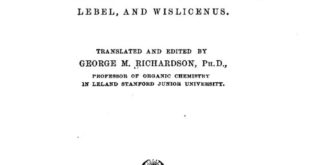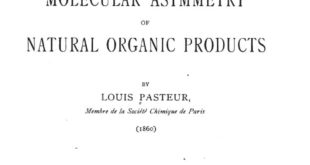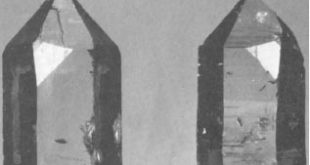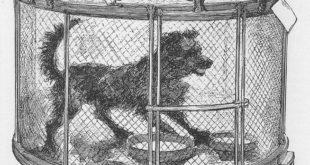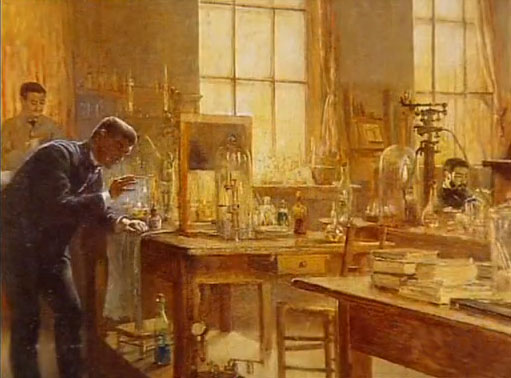
The most ordinary observation has at all times demonstrated that animal and vegetable substances, exposed after death to contact with atmospheric air, or buried in the earth, disappear, in consequence of various transformations.
Fermentation, putrefaction, and slow combustion, are the three phenomena which concur in the accomplishment of this great fact of the destruction of organic substances–a condition necessary for the maintenance of life on the earth …
Dead substances that ferment or putrefy do not yield solely to forces of a purely physical or chemical nature. It will be necessary to banish from science the whole of that collection of preconceived opinions which consist in assuming that a certain class of organic substances–the nitrogenous plastic substances–may acquired, by the hypothetical influence of direct oxidation, an occult power, characterised by an internal agitation, communicable to organic substances supposed to have little stability …
In every case, life, manifesting itself in the lowest forms of organization, appears to me to be one of the essential conditions of these phenomena, but life of a nature unknown hitherto; that is to say, without consumption of air or of free oxygen.
I today endeavour to demonstrate experimentally that the slow combustion which takes place in dead organic substances, when they are exposed to the air has, in most cases, an equally intimate connection with the presence of the lowest forms of life. This leads to the general conclusion that life controls the work of death in all its phases, and that the three terms of that perpetual return to the atmosphere, and to the mineral kingdom, of the elements which vegetables and animals have abstracted from them, are correlative acts of development and of the multiplication of organised beings …
On 25 May 1860, in the open air in a garden I broke off the narrow and sealed end of an exhausted flask of 250 cubic centimetres capacity, containing 80 cubic centimetres of sugar solution with yeast, which had been heated to boiling. Immediately after admitting the air, I sealed the point of the flask with a lamp … It very often happens, for example, that the liquid in the flask subsequently does not give rise either to the production of infusoria or moulds and it retains its original limpidity, although common air was admitted to the flask when it was opened. This was precisely the case with the above-mentioned flask. The liquid was still unaltered on 5 February 1863, on the day I analysed the air in the flask. This air contained:
| Oxygen | 18.1 |
| Carbonic acid | 1.4 |
| Nitrogen by difference | 80.5 |
| 100.0 |
Therefore it is obvious that during the period of three years the albuminous substances of the beer yeast water mixed with sugared water and exposed to ordinary air, but under conditions in which animalcules and or moulds were not developed, had absorbed 2.7 per cent of oxygen, which they had partially converted into carbonic acid. Direct oxidation, slow combustion was therefore barely perceptible. Notwithstanding that during the three years the flask had been kept in a stove at 25° to 30° for eighteen months.
On 22 March 1860 I filled a flask of 250 cubic centimetres capacity, containing 60 to 80 cubic centimetres of boiled urine … with air deprived of germs through a higher temperature. The liquid was perfectly clear in January 1863. Its colour tended slightly into a reddish-brown tint. A crystalline sandy deposit of uric acid had separated in small quantity on the sides of the flask. Moreover there were some clusters of needles which I recognized as calcium phosphate crystals. The urine was still acid, but this acidity was reduced rather than increased. Its smell recalled exactly the odour of fresh urine after boiling. The air of the flask contained:
| Oxygen | 11.4 |
| Carbonic acid | 11.5 |
| Nitrogen by difference | 77.1 |
| 100.0 |
Thus after three months there still remained 11 to 12 per cent of oxygen. Moreover, all absorbed oxygen is recovered in carbonic acid, less the difference that may always result from the coefficients of solubility of two gases in the experimental liquid.
Be that as it may, it is obvious how slow and difficult is the direct oxidation of urinary substances by atmospheric air, when this air is placed under conditions unsuitable for promoting the development of lower organized beings …
To sum up, in studying the slow combination of dead organic substances under the influence of atmospheric oxygen, it is found that this combustion is not in doubt and that it varies in intensity and in mode of action. According to the nature of the organic substances comparably to metals that are not oxidized by air, such as gold and platina, to some that are moderately oxidizable, such as copper and lead, finally to others that are very prone to oxidation, such as potassium and sodium.
But [it] is worthy of remark, and this is precisely the principal fact to which I today wish to draw the attention of the Academy: the slow combustion of organic substances after death, however real, is barely perceptible when the air is deprived of the germs of lower organisms. It becomes rapid, considerable, not to be compared with the former situation, should the organic substances be covered by moulds, mucors, bacteria, monads. These small beings are agents of combustion the energy of which varying in accordance with their specific nature is sometimes extraordinary, as strikingly exemplified by the oxidation of alcohol, acetic acid, sugar by mycodermas of which I have informed the Academy a year ago.
The proximate principles of living bodies might in some way remain indestructible if from the assembly of beings created by God the smallest, on the surface the most useless ones, would be removed. And life would become impossible because the restoration of all that which has ceased to live, to the atmosphere and to the mineral kingdom, would be all of a sudden suspended.
For all that, if I restricted myself to the above experiments, I might open myself to a serious objection… I have constantly worked not only on organic substances that were dead but, moreover, they were previously heated to the boiling point of water. Now, it cannot be doubted that organic substances are profoundly modified by a temperature of 10°. It was therefore necessary to study the possibility of slow combustion of natural organic substances that have not been previously heated, that have in short remained unaltered.
… I have succeeded in exposing to air, free from germs, fresh liquids that are highly susceptible to putrefaction … blood and urine … at present what I should like to call attention is above all to the slight activity of slow combustion, of direct oxidation of the constituents of blood … Direct oxidation of urinary substances is equally imperceptible. After forty days I found in one of the flasks:
| Oxygen | 19.2 |
| Carbonic acid | 0.8 |
| Nitrogen by difference | 80.0 |
| 100.0 |
The conclusions to which I have been led by the first series of experiments are therefore applicable in any case to organic substances whatever their structural condition… Doubtless it will be superfluous to observe that the experiments regarding blood and urine which I have just talked about to the Academy strike the last blow at the doctrines of spontaneous generation as well as at the modern theory of fermentation.
 Pasteur Brewing Louis Pasteur – Science, Health, and Brewing
Pasteur Brewing Louis Pasteur – Science, Health, and Brewing 